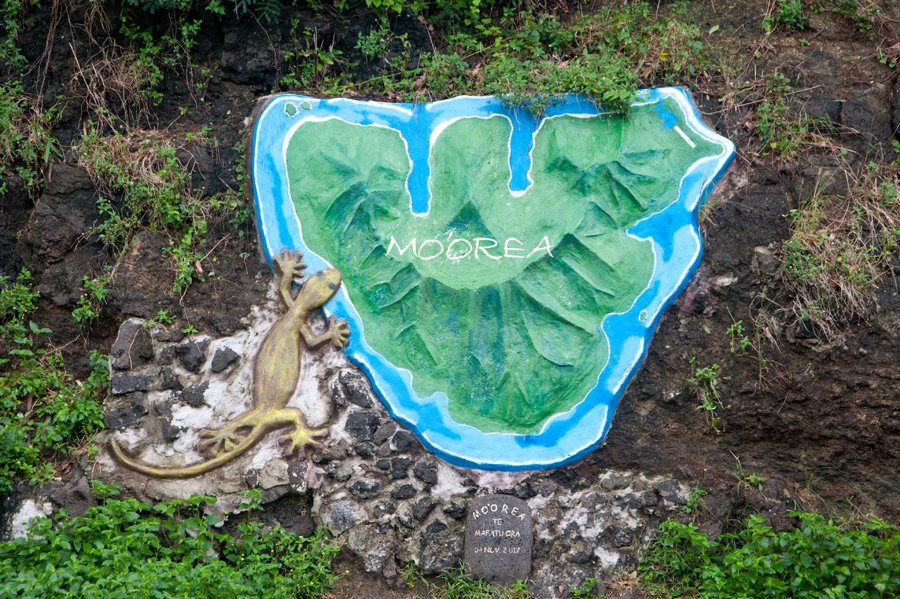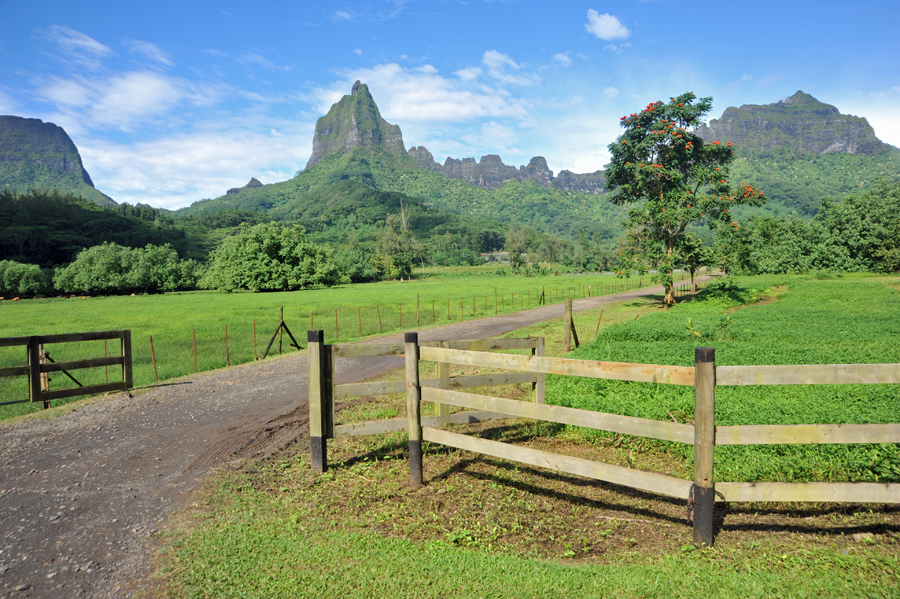Every now and then, we happen to find ourselves in a place rendering us utterly speechless. Mo’orea is one of those places.
Located just 16km (10 miles) west of Tahiti, Mo’orea is clearly visible from the western shore and is home to fewer than 20,000 people. Almost every time we catch a glimpse of Mo’orea, it seems to have a cloud over it. This is because of the massive peaks rising steeply from the ocean some 1,207 meters (3,960 ft) at the highest peak, Mount Tohivea. These peaks catch the clouds and cause rain ensuring the volcanic soil in the valley maintains the lush vegetation.
We toyed with the idea of taking Cream Puff over to Mo’orea but instead decided to take a vacation from the boat and rent a cottage. In addition, we also opted to rent a car for a few days and be our own tour-guides. We love doing this. Our journey begins with a ferry ride to the island.
The ferry terminal is just a short walk from the marina where we are staying, another great benefit of being downtown in Pape’ete. The terminal itself is an architectural wonder. It is a massive building with dark wood columns and large roof overhangs to keep people dry in the rainy season. We purchased our tickets online saving the need to have to communicate in French. But arriving there, we find almost everyone working there speaks enough English to communicate with tourists.
Lucky me, I qualify for the senior rate ticket and mine is half the price of Cindy’s. Our total fare for the two of us, round trip, is 4,900 xpf (US$47). Deal! Sometimes the graying hair has benefits.
At the ferry terminal, we try to make heads and tails of the procedure. It all seems very complicated but turns out to be very easy. Toss the bag on a cart. No need to check it. No receipt or claim tag issued. Just toss it on the cart for the boat Aremiti Ferry II. This is when you start to realize life on a small island has advantages – more on this later. People here do not steal other people’s bags. They just trust you to put your bag on the carts and pick them up on the other side. There is no picture ID required when checking in. The printout from the computer is scanned and off we go.
Following the crowd is how we navigate. We look for someone who has obviously done this a few times. We pick a Tahitian lady with a flower in her hair and follow her. By the way, flowers in the hair are not something they do just for tourists. This is, and has been for a very long time, a part of the culture of Polynesian people.
When sitting on Cream Puff in the mornings looking at the promenade in Pape’ete, I often see ladies stop to pick a fresh flower from one of the trees and place it in their hair. We sit on a bench near our unknown guide. I make the mistake of coughing, really nothing more than a clearing of the throat. The lady moves away. I can’t say I blame her. The islands are starting to open to tourists again and people are very wary of foreigners.
We hang out at Gate 3 with our backpacks. When you consider we travel with camera gear taking more space than our clothes, we travel light. My toiletry pack nowadays consists of a toothbrush, toothpaste, and deodorant. The days of traveling with a razor are long gone. The crowd starts to move toward our corner of the room. Our flowered guide has put us near the door opening to the boarding ramp. We knew she looked like a person who had done this before. There is a desire by the locals to board at the beginning of the process. This is the first time I have seen islanders in a hurry for anything. Once aboard, we find out why.
The ferry is ultra-modern, spotlessly clean, and enormous. Inside, we see rows and rows of seats. None are assigned. We decide to turn right since this is the way the seats are facing and claim two seats at the very front of the salon giving us a great view of the loading process. Why are the locals in a hurry? They turned left. To the left, breakfast is being served cafeteria-style in the rear salon. The ride is 45 minutes. This is the perfect amount to enjoy a croissant and coffee. It seemed like the preferred seating in the rear salon (where food and drink are allowed) is a table by the window. This is what the hurry was about. Parking themselves at a table near a window with fresh coffee and pastry, what better way to spend the passage?
The ocean never ceases to amaze us. Even sitting on this large ferry we can feel the swells. It is a little bit windy for the crossing. Coupled with the fact there is a strong current between the islands, this makes the passage choppy. This time of year in French Polynesia they get what the locals refer to a mara’amu winds. From July to September, the wind can change and come from the south and easily reach force 6-7 (25-30 knots). Often with the mara’amu rain and clouds coincide. For our trip, we hope for clouds and little rain. Clouds make photography better since there are no harsh shadows to deal with. They also keep the temperature tolerable. A mara’amu will blow in about every other week.
We disembark the ferry at the Mo’orea terminal and cross the street to the Avis Rental Car facility. This is where we pick up our tiny car. And I mean, tiny car. It is a BYD car. Never heard of it? It is made in China. I guessing it cost all of US$3.78 to manufacture. It is very stripped down. But, it is perfect for what we need to drive the single road around Mo’orea.
There is one main road on the island. So, it doesn’t matter if we turn left or right exiting the Avis facility. We are going to get to our Airbnb rental regardless of which way we decide to go. To drive the entire circumference of the island is about 60 km (37 miles). It takes about an hour to drive all the way around. There are no highways, it is a two-lane road (in great condition) and the speed limit is 60 kmh (about 37 mph). And besides, I don’t think our little Chinese car would go much faster than this.
We decide to turn right. According to our Avis map, yes – they gave us a map of the single road; we think there is a grocery store. We find the Champion store and stock up on food for the next few days. One of the things we enjoy when we rent a house is having a real kitchen. We also like unlimited water, electricity, and Wi-Fi. We have really learned to appreciate the basics of life. The fact that we can live more than 10 feet apart from one another for the next few days is also appealing. Living on a boat together, the word together has a literal meaning.
Our directions to the house are: from the ferry terminal, go past the two bays, once past the second bay look for a blue and white fence and a sign for the house. There is no address. From the grocery store, this time we decide to turn left. The first thing we notice is the smells.
When we landed in Tahiti, we’d been at sea for almost 30 days. One of the fun things when making landfall is re-discovering our sense of smell. In the ocean, there is not much to smell. The sea smells like the sea. Unless a flying fish lands on the boat, not much changes. Flying fish stink. I swear, the sense of smell becomes dormant when we are underway. As we entered Tahiti’s main harbor Cindy said, it smells like coconuts here. It really does.
There are few places on earth where beautiful smells waft through the car windows as a person meanders about the island. The first time I ever experienced this was Maui. Driving the back-roads (in violation of our rental-car agreement), we notice the flowery aromas differing from bay to bay. The same is true on Mo’orea. Mo’orea smells like Gardenias. The sweet succulent aroma comes from the flowers all along the roadside. They drift into the tiny Chinese car through the open windows. We run the car with the air-conditioning off so we can get the extra 10 kph of speed.
Traveling to our house, our breath is taken away. Beautiful turquoise lagoons are on one side of the car and massive green mountains are on the other side. I swear, keeping one’s eyes on the road is really really really hard. I’m surprised they don’t lose tourists off the sides of the road into the water. Perhaps they do.
The local motorists are very patient with us. More than once, I catch myself driving slowly and looking everywhere but the road. Our rental car is identified with a big orange dot on the front and back. I’m guessing the locals know that rental cars are likely to do some very strange maneuvers. They give us space and don’t ride our rear bumper. I try to pull over to the side of the road as the cars back up behind us. People wave and smile as they pass. I’m not used to this. I am used to getting the one-finger salute from other drivers as I drive slowly taking in the sights. Perhaps it is common knowledge among the locals the little Chinese rental cars identified with big orange dots just don’t go very fast.
So, back to what I mentioned earlier about the advantages of island life. Some of which I find incredibly appealing. Cindy and I have a secret hope. Our dream is to one day pull into a port so beautiful we never want to leave. We sell the boat and settle into our new utopia and live long and peaceful lives. We sit on the veranda with good friends swapping stories of life and our travels about the globe while sipping good cheap wine. Mo’orea isn’t quite it. But it’s close. Bermuda still has the top spot on my list. But, alas it is just too expensive now. We’ll just have to keep looking.
Imagine this: living in a place with no violent crime. The murder rate of French Polynesia is almost the lowest in the world, per capita. When a Tahitian travels to the USA, their chances of being killed goes up over 1,000%. And, the USA does not have a statistically high per capita murder rate. It is sort of in the middle of the pack. I tried to find when the last murder occurred on Mo’orea. I have a very morbid curiosity sometimes. The latest one I could find took place in 2002, some eighteen years ago. And guess what, it was an American killing another American on their yacht while visiting there.
Traveling about on Mo’orea, we see youngsters walking by themselves. I can assume they are off to a friend’s house and then perhaps for a swim in the lagoon. I can’t help but think of parents we know that would freak out if their child was out of sight for more than a minute. Yep! There is something to be said for living on a small island like Mo’orea. There is not much to worry about. Live is good here.






















